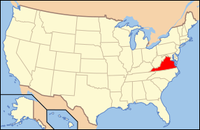| ||||||||||||||
| Nottoway County, Virginia | ||
| ||
 Location in the state of Virginia | ||
 Virginia's location in the U.S. | ||
| Founded | 1789 | |
|---|---|---|
| Seat | Nottoway | |
| Area - Total - Land - Water |
, 0.46% | |
| Population - (2000) - Density |
15,725 | |
| Website | www.nottoway.org | |
Nottoway County is a county located in the U.S. state — officially, "Commonwealth" — of Virginia. As of the 2000 census, the population was 15,725. Its county seat is Nottoway6.
Geography
According to the U.S. Census Bureau, the county has a total area of 819 km² (316 mi²). 815 km² (315 mi²) of it is land and 4 km² (1 mi²) of it (0.46%) is water.
Demographics
As of the census2 of 2000, there were 15,725 people, 5,664 households, and 3,885 families residing in the county. The population density was 19/km² (50/mi²). There were 6,373 housing units at an average density of 8/km² (20/mi²). The racial makeup of the county was 57.16% White, 40.56% Black or African American, 0.13% Native American, 0.39% Asian, 0.03% Pacific Islander, 1.01% from other races, and 0.72% from two or more races. 1.58% of the population were Hispanic or Latino of any race.
There were 5,664 households out of which 29.90% had children under the age of 18 living with them, 48.60% were married couples living together, 15.40% had a female householder with no husband present, and 31.40% were non-families. 27.60% of all households were made up of individuals and 14.20% had someone living alone who was 65 years of age or older. The average household size was 2.48 and the average family size was 3.00.
In the county, the population was spread out with 22.90% under the age of 18, 8.10% from 18 to 24, 29.30% from 25 to 44, 22.60% from 45 to 64, and 17.10% who were 65 years of age or older. The median age was 39 years. For every 100 females there were 106.60 males. For every 100 females age 18 and over, there were 106.60 males.
The median income for a household in the county was $30,866, and the median income for a family was $39,625. Males had a median income of $28,533 versus $19,718 for females. The per capita income for the county was $15,552. About 15.50% of families and 20.10% of the population were below the poverty line, including 27.70% of those under age 18 and 18.40% of those age 65 or over.
History
Prior to the arrival of European settlers, the land that would become Nottoway County was inhabited by American Indians of the Nadowa tribe, an Iroquoian people. Living along the county’s only river, the name Nadowa, meaning rattlesnake, became associated with the area they inhabited. The name was Anglicized to ‘Nottoway’.
Before the county established its own government, it was known as Nottoway Parish, a district of Amelia County. Nottoway Parish became Nottoway County by legislative act in 1788. The county contained numerous early crossroads settlements connecting the new western frontier with the population centers of Petersburg and Richmond to the north and east and until recent times owed much of its prospertity to tobacco. First coming to Nottoway in the 1850's, railroad construction and associated industries eventually came to represent a major portion of business in the area. In fact, one of the county's larger towns, Crewe, owes its existence to the railroad siding established at Robertson's Switch in the 1880's. In recent decades, however, the decline of tobacco and the railroads has presented the county, like much of Southside Virginia, with economic difficulties and lead many Nottoway families to seek jobs and homes in Richmond and other prospering cities in the central Virginia.
During the Civil War, the county contributed to the Confederate cause raising two infantry companies, the Nottoway Rifle Guards, and Capt. Richard Irby's Nottoway Grays; Jeffress' artillery battery; and the Nottoway Troop of the 3rd Virginia Cavalry. The two infantry companies served in the 18th Virginia Regiment and saw extensive service throughout the Eastern Theatre, but most notably at the Battle of Gettysburg where they were situated at the forefront of Pickett's Charge. The infamous charge wrought a devastating effect on the 18th Virginia and many a family at home in Nottoway County. The 18th's colors were captured at the wall on Cemetery Ridge and are now on display in Gettysburg. The county itself was the site of only one significant skirmish during the war, the “Battle of the Grove,” which was fought near Blackstone (then known as Blacks and Whites) for control of the rail line that supplied General Robert E. Lee’s Army of Northern Virginia then entrenched around Petersburg and Richmond.
The County's three towns were incorporated in the late 1800s, all along what was to become the U.S. Highway 460/Norfolk Southern Railway corridor that bisects the County. Industrialization blossomed at the same time, exploiting the ease of moving raw materials in and finished products out. County manufacturing often utilized the area’s abundant natural resources, particularly agricultural products, timber, and wood products.
The 20th century saw an increase in the diversification of the County in its agricultural, industrial and commercial sectors. During this time, major state and federal facilities were created in the County. Fort Pickett, established at the outbreak of World War II, is noted as one the finest military training facilities in the east.
Towns
| This page uses content from the English language Wikipedia. The original content was at Nottoway County, Virginia. The list of authors can be seen in the page history. As with this Familypedia wiki, the content of Wikipedia is available under the Creative Commons License. |
